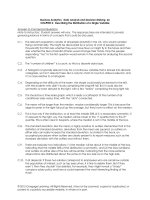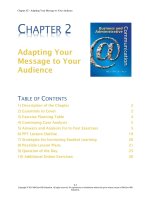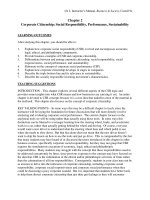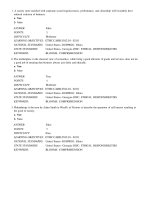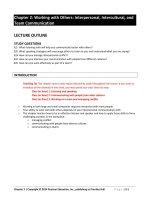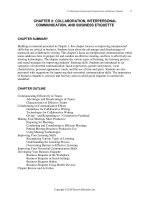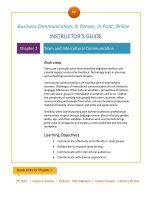Test bank and solution of business communication developing leader 2e (1)
Bạn đang xem bản rút gọn của tài liệu. Xem và tải ngay bản đầy đủ của tài liệu tại đây (3.04 MB, 33 trang )
Instructor’s Manual to Accompany
BUSINESS COMMUNICATION
Developing Leaders for a Networked World (2e)
By Peter W. Cardon
Chapter 2:
Interpersonal
Communication and
Emotional Intelligence
IM 2-1
© 2016 by McGraw-Hill Education. This is proprietary material solely for authorized instructor use. Not authorized for sale or distribution in any
manner. This document may not be copied, scanned, duplicated, forwarded, distributed, or posted on a website, in whole or part.
Teaching Note
Hello Fellow Instructor,
Strong interpersonal skills have always been a key to professional success. However, in the past five
years, I’ve noticed an even increased demand among employers for interpersonal skills.
A lot of factors in the contemporary workplace can hinder effective interpersonal communication,
including various communication technologies, the fast pace of business, and other pressures and
disruptions in the workplace.
This chapter is an opportunity to start a conversation about building deep, collaborative relationships in
the workplace. Furthermore, it provides the language to talk about business relationships in every
remaining chapter.
Please contact me anytime – to share your experiences, your ideas, and your requests.
Best of wishes,
Peter W. Cardon, MBA, Ph.D.
Associate Professor
Center for Management Communication
University of Southern California
Email:
Twitter: @petercardon
Facebook: facebook.com/cardonbcomm
Web: cardonbcom.com
IM 2-2
© 2016 by McGraw-Hill Education. This is proprietary material solely for authorized instructor use. Not authorized for sale or distribution in any
manner. This document may not be copied, scanned, duplicated, forwarded, distributed, or posted on a website, in whole or part.
Chapter 2 Summary and PowerPoint Notes
SLIDE 2-1
SLIDE 2-2
This chapter covers the following topics: the
communication process and barriers to
communication; emotional hijacking and selfawareness; impacts of self-management; active
listening; how to read non-verbal communication;
communication preferences; impact of
introversion-extroversion; and types of civility.
SLIDE 2-3
LO2.1 Describe the interpersonal communication
process and barriers to effective communication.
LO2.2 Explain how emotional hijacking can hinder
effective interpersonal communication.
LO2.3 Explain how self-awareness impacts the
communication process.
LO2.4 Describe how self-management impacts the
communication process.
LO2.5 Explain and evaluate the process of active
listening.
IM 2-3
© 2016 by McGraw-Hill Education. This is proprietary material solely for authorized instructor use. Not authorized for sale or distribution in any
manner. This document may not be copied, scanned, duplicated, forwarded, distributed, or posted on a website, in whole or part.
SLIDE 2-4
LO2.6 Describe and demonstrate effective
questions for enhancing listening and learning.
LO2.7 Explain strategies to sight-read the
nonverbal communication of others.
LO2.8 Identify common communication
preferences based on motivational values.
LO2.9 Explain how extroversion-introversion
impacts interpersonal communication.
LO2.10 Explain the role of civility in effective
interpersonal communication and the common
types of incivility in the workplace.
SLIDE 2-5
In nearly any poll of skills needed for career
success, employees identify interpersonal skills as
the most important. For example, consider the
results of a recent Gallup poll of working adults,
depicted in Table 2.1. More than any other item in
the survey, respondents recognized “skill in dealing
with people” as the most critical.
SLIDE 2-6
To engage in effective interpersonal
communication, focus on the following two tasks:
Task 1 Overcome barriers to communication.
Task 2 Manage emotions to engage in constructive
communication.
IM 2-4
© 2016 by McGraw-Hill Education. This is proprietary material solely for authorized instructor use. Not authorized for sale or distribution in any
manner. This document may not be copied, scanned, duplicated, forwarded, distributed, or posted on a website, in whole or part.
SLIDE 2-7
We often take the interpersonal communication
process for granted, rarely thinking about its
building blocks and how they influence the quality
of our communications. However, consciously
becoming aware of these basic elements can help
you improve your interpersonal communications
skills and work more effectively with others. The
interpersonal communication process is the
process of sending and receiving verbal and
nonverbal messages between two or more people.
It involves the exchange of simultaneous and
mutual messages to share and negotiate meaning
between those involved.
SLIDE 2-8
The interpersonal communication process,
depicted in Figure 2.1, is the process of sending
and receiving verbal and nonverbal messages
between two or more people.
IM 2-5
© 2016 by McGraw-Hill Education. This is proprietary material solely for authorized instructor use. Not authorized for sale or distribution in any
manner. This document may not be copied, scanned, duplicated, forwarded, distributed, or posted on a website, in whole or part.
SLIDE 2-9
Each person involved in interpersonal
communication is both encoding and decoding
meaning. Meaning refers to the thoughts and
feelings that people intend to communicate to one
another.
SLIDE 2-10
Encoding is the process of converting meaning into
messages composed of words and nonverbal
signals. Decoding is the process of interpreting
messages from others into meaning. In the
interpersonal communication process,
communicators encode and send messages at the
same time that they also receive and decode
messages.
SLIDE 2-11
One goal of interpersonal communication is to
arrive at shared meaning—a situation in which
people involved in interpersonal communication
attain the same understanding about ideas,
thoughts, and feelings.
IM 2-6
© 2016 by McGraw-Hill Education. This is proprietary material solely for authorized instructor use. Not authorized for sale or distribution in any
manner. This document may not be copied, scanned, duplicated, forwarded, distributed, or posted on a website, in whole or part.
SLIDE 2-12
In practice, many barriers interfere with achieving
shared meaning, including external noise, internal
noise, and lifetime experiences. Noise causes
distortion to or interruption of messages. Four
types of noise affect the quality of message
delivery: physical noise, physiological noise,
semantic noise, and psychological noise. Physical
noise is external noise. The other three types of
noise are distortions or interruptions of massages
that are caused by internal characteristics of
communicators.
SLIDE 2-13
Physical noise is external noise that makes a
message difficult to hear or otherwise receive.
Examples include loud sounds nearby that
interrupt verbal signals or physical barriers that
prevent communicators from observing nonverbal
signals. Physical noise can also be a function of the
medium used. A poor signal for a phone
conversation and blurry video feed for a
teleconference are examples of physical noise.
Physiological noise refers to disruption due to
physiological factors. Examples include hearing
problems, illness, memory loss, and so on.
Conversely, a communicator may have a difficult
time sending a message due to physiological
constraints such as stuttering, sickness, or other
temporary or permanent impairments.
IM 2-7
© 2016 by McGraw-Hill Education. This is proprietary material solely for authorized instructor use. Not authorized for sale or distribution in any
manner. This document may not be copied, scanned, duplicated, forwarded, distributed, or posted on a website, in whole or part.
SLIDE 2-14
Semantic noise occurs when communicators apply
different meanings to the same words or phrases.
For example, two people may have different ideas
about what an acceptable profit margin means.
One manager may have a figure in mind, such as 10
percent. Another may think of a range between 20
and 30 percent. Semantic noise can be most
difficult to overcome when strong emotions are
attached to words or phrases.
Psychological noise refers to interference due to
attitudes, ideas, and emotions experienced during
an interpersonal interaction. In many cases, this
noise occurs due to the current conversation—the
people involved or the content. The demanding
impacts of day-to-day business can create
psychological noise for many reasons.
SLIDE 2-15
All outgoing messages are encoded and all
incoming messages are decoded through a filter of
lifetime experiences. This filter is an accumulation
of knowledge, values, expectations, and attitudes
based on prior personal experiences. When people
have more shared experiences, communication is
easier. However, people who grew up in different
communities or cultures and at different times,
who have far different educational backgrounds,
and who have worked in different industries are far
more likely to filter incoming messages differently.
As a result, they are more likely to encounter noise
and are less equipped to deal with the noise.
IM 2-8
© 2016 by McGraw-Hill Education. This is proprietary material solely for authorized instructor use. Not authorized for sale or distribution in any
manner. This document may not be copied, scanned, duplicated, forwarded, distributed, or posted on a website, in whole or part.
SLIDE 2-16
The ability to manage effective interpersonal
communication depends on emotional intelligence.
Emotional intelligence involves understanding
emotions, managing emotions to serve goals,
empathizing with others, and effectively handling
relationships with others. Business managers with
high emotional intelligence are more effective at
influencing others, overcoming conflict, showing
leadership, collaborating in teams, and managing
change. Furthermore, research has shown
emotional intelligence leads to better outcomes in
business reasoning and strategic thinking. You may
see emotional intelligence referred to as EQ, which
stands for emotional quotient, a play on the term
IQ, intelligence quotient.
SLIDE 2-17
The primary reason that emotional intelligence is
so critical is physiological: People are hardwired to
experience emotions before reason. All signals to
the brain first go through the limbic system, where
emotions are produced, before going to the
rational area of the brain (see Figure 2.3).
People may experience emotional hijacking, a
situation in which emotions control our behavior
causing us to react without thinking. The impacts of
emotions last long after they’ve subsided.
Emotional hijacking prevents you from engaging in
effective interpersonal communication. It can lead
to unwanted behaviors.
IM 2-9
© 2016 by McGraw-Hill Education. This is proprietary material solely for authorized instructor use. Not authorized for sale or distribution in any
manner. This document may not be copied, scanned, duplicated, forwarded, distributed, or posted on a website, in whole or part.
SLIDE 2-18
The most-used EQ test for business professionals
shows that emotional intelligence can be divided
into four domains: self-awareness, selfmanagement, empathy, and relationship
management.
SLIDE 2-19
Self-awareness is the foundation for emotional
intelligence. It involves accurately understanding
your emotions as they occur and how they affect
you. One prominent researcher defines selfawareness as “ongoing attention to one’s internal
states.” People high in self-awareness understand
their emotions well, what satisfies them, and what
irritates them. Understanding your emotions as
they occur is not always easy. In fact, research
indicates that just 36 percent of people can
accurately identify their emotions as they occur.
SLIDE 2-20
Table 2.2 shows differences in low versus high selfawareness in the encounter between Jeff and
Latisha.
IM 2-10
© 2016 by McGraw-Hill Education. This is proprietary material solely for authorized instructor use. Not authorized for sale or distribution in any
manner. This document may not be copied, scanned, duplicated, forwarded, distributed, or posted on a website, in whole or part.
SLIDE 2-21
Self-management is the “ability to use awareness
of your emotions to stay flexible and to direct your
behavior positively.” It involves the discipline to
hold off on current urges to meet long-term
intentions. Excellent self-managers know how to
use both positive and negative emotions to meet
personal and business goals.
SLIDE 2-22
People can quickly control moderate negative
emotions. For example, an individual who tries to
understand mitigating information can shortcircuit moderate anger almost immediately.
Mitigating information involves favorable
explanations for why others have behaved in a
certain way. See Table 2.4 for examples of low
versus high self-management and the use of
mitigating information.
SLIDE 2-23
Empathy is the “ability to accurately pick up on
emotions in other people and understand what is
really going on with them.” Empathy also includes
the desire to help others develop in their work
responsibilities and career objectives. Relationship
management is “the ability to use your awareness
of emotions and those of others to manage
interactions successfully.”
IM 2-11
© 2016 by McGraw-Hill Education. This is proprietary material solely for authorized instructor use. Not authorized for sale or distribution in any
manner. This document may not be copied, scanned, duplicated, forwarded, distributed, or posted on a website, in whole or part.
SLIDE 2-24
Michael Hoppe of the Center for Creative
Leadership has defined active listening as “a
person’s willingness and ability to hear and
understand. At its core, active listening is a state of
mind. . . . It involves bringing about and finding
common ground, connecting to each other, and
opening up new possibilities.” Hoppe breaks down
active listening into six skills: (1) paying attention,
(2) holding judgment, (3) reflecting, (4) clarifying,
(5) summarizing, and (6) sharing.
SLIDE 2-25
This first step involves devoting your whole
attention to others and allowing them enough
comfort and time to express themselves
completely. As others speak to you, try to
understand everything they say from their
perspective. Paying attention requires active
nonverbal communication. Your body language,
including appropriate eye contact, should show
you are eager to understand the other person.
Lean forward. Keep an open body position. Sit up
straight. Nod to show you are listening. Smile as
appropriate. Pay attention to the speaker’s
nonverbal behaviors. Avoid any distractions.
SLIDE 2-26
People will share their ideas and feelings with you
only if they feel safe. Holding judgment is
particularly important in tense and emotionally
charged situations. One of the best ways to make
others feel comfortable expressing themselves fully
is to demonstrate a learner mind-set rather than a
judger mind-set. Holding judgment does not mean
that you agree with everything you hear. It also
does not mean you avoid critiquing the ideas of
others. Rather, it’s a commitment to hearing the
IM 2-12
© 2016 by McGraw-Hill Education. This is proprietary material solely for authorized instructor use. Not authorized for sale or distribution in any
manner. This document may not be copied, scanned, duplicated, forwarded, distributed, or posted on a website, in whole or part.
entire version of others’ ideas and experiences. It’s
a commitment to listen fully before reacting. And,
it’s a mind-set of rewarding others for opening up,
especially when you disagree with them.
SLIDE 2-27
In a learner mind-set, you show eagerness to hear
others’ ideas and perspectives and listen with an
open mind. You do not have your mind made up
before listening fully. When you disagree, you stay
open to the possibility of finding common ground
and mutually beneficial solutions. Under the
learner mind-set, difference of opinion is
considered normal, even healthy, and potentially
solution producing.
SLIDE 2-28
In a judger mind-set, people have their minds
made up before listening carefully to others’ ideas,
perspective, and experiences. Judgers view
disagreement rigidly, with little possibility of
finding common ground unless the other person
changes his or her views. Judging often involves
punishing others for disagreement. At its extreme,
the judger mindset involves ascribing negative
traits to others and labeling them in undesirable
terms.
IM 2-13
© 2016 by McGraw-Hill Education. This is proprietary material solely for authorized instructor use. Not authorized for sale or distribution in any
manner. This document may not be copied, scanned, duplicated, forwarded, distributed, or posted on a website, in whole or part.
SLIDE 2-29
You can create an environment in which others
open up and you can listen more effectively with
learner statements, which show your commitment
to hearing people out. In effective learner
statements, you explicitly state your desire to hear
differing opinions with statements such as “I have a
different perspective, so I want to understand how
you see this.” By contrast, people who make judger
statements, which show they are closed off to
hearing people out, shut down honest
conversations.
SLIDE 2-30
Notice the distinctions between judger statements
and learner statements in this conversation in
Table 2.6.
SLIDE 2-31
Active listening requires that you reflect on the
ideas and emotions of others. To make sure you
really understand others, you should frequently
paraphrase what you’re hearing.
IM 2-14
© 2016 by McGraw-Hill Education. This is proprietary material solely for authorized instructor use. Not authorized for sale or distribution in any
manner. This document may not be copied, scanned, duplicated, forwarded, distributed, or posted on a website, in whole or part.
SLIDE 2-32
As Table 2.7 shows, good reflecting statements
begin with phrases such as, “It sounds like you
think . . .”; “So, you’re not happy with . . .”; or “Let
me make sure I understand. . . .”
SLIDE 2-33
Clarifying involves making sure you have a clear
understanding of what others mean. It includes
double-checking that you understand the
perspectives of others and asking them to
elaborate and qualify their thoughts. It is more
than simply paraphrasing. It involves trying to
connect the thoughts of others so you can better
understand how they are making conclusions.
SLIDE 2-34
As Table 2.8 shows, good clarifying questions are
open-ended and start with learner-oriented
phrases such as, “What are your thoughts on . . .?”
or “Could you explain how. . .?”
IM 2-15
© 2016 by McGraw-Hill Education. This is proprietary material solely for authorized instructor use. Not authorized for sale or distribution in any
manner. This document may not be copied, scanned, duplicated, forwarded, distributed, or posted on a website, in whole or part.
SLIDE 2-35
The goal of summarizing is to restate major themes
so that you can make sense of the big issues from
the perspective of the other person. Ideally, you
can show that you understand the major direction
of the conversation.
Active listening also involves expressing your own
perspectives and feelings. If you do not share your
own ideas completely, your colleagues do not
know what you really think. This is not fair to them
or to you. It is even arguably dishonest.
SLIDE 2-36
You can summarize with statements that begin
with phrases such as “So, your main concern is . . .”
or “It sounds as though your key points are . . . ,” as
shown in Table 2.9.
SLIDE 2-37
Active listening is not easy, especially in certain
corporate cultures and in the face of time
constraints. Some barriers to listening are lack of
time, lack of patience and attention span, image of
leadership, communication technology, fear of bad
news, defending, “Me too” statements, advicegiving, and judging. Consider which barriers to
listening are most challenging to you.
IM 2-16
© 2016 by McGraw-Hill Education. This is proprietary material solely for authorized instructor use. Not authorized for sale or distribution in any
manner. This document may not be copied, scanned, duplicated, forwarded, distributed, or posted on a website, in whole or part.
SLIDE 2-38
Figure 2.4 displays defensive and non-defensive
replies to a potentially upsetting comment.
Avoiding defensiveness requires a high level of selfawareness and self-management. It requires
understanding the triggers that make you feel
threatened in a professional environment. It also
requires understanding how to manage these
emotions so that you can maintain your roles as an
active listener and a problem solver.
SLIDE 2-39
Listening involves a cluster of communication skills.
A crucial one is the ability to ask the right
questions. On the most fundamental level, good
questions reflect the learner mind-set, and poor
questions reflect a judger mind-set. The ability to
ask good questions creates a culture of learning.
Good questions are not good in and of themselves,
however. Unless you truly listen to the answers
and even encourage other perspectives and
dissent, you may not achieve learning. Notice
examples of questions in Table 2.10 that reflect
judger mind-sets and learner mind-sets.
SLIDE 2-40
Generally speaking, most good questions are openended. In contrast, closed questions require simple
responses such as yes or no. Some basic types of
learning-centered questions include rapportbuilding questions, funnel questions, probing
questions, and solution-oriented questions. See
Table 2.11 for examples of each type of question.
IM 2-17
© 2016 by McGraw-Hill Education. This is proprietary material solely for authorized instructor use. Not authorized for sale or distribution in any
manner. This document may not be copied, scanned, duplicated, forwarded, distributed, or posted on a website, in whole or part.
SLIDE 2-41
Most poor questions fall into the category of the
judgmental mind-set and can actually lead to less
listening. Poor questions include leading questions,
disguised statements, and cross-examination
questions. Table 2.12 provides examples.
SLIDE 2-42
People can learn sight-reading, which David Givens
of the Center for Nonverbal Studies defines as
“intelligent observation [of nonverbal
communications] . . . it is the act of anticipating
intentions and moods through the perceptive
examination of nonverbal cues.” Generally, you
should pay close attention to nonverbal signals and
attempt to decode their meanings. Yet, always
make sure to suspend a certain level of judgment
and avoid rigid conclusions. Consider the following
guidelines as you develop your sight-reading:
Consciously practice each day.
Pay attention to congruence.
Sight-read in clusters, not in isolation.
Sight-read in context.
IM 2-18
© 2016 by McGraw-Hill Education. This is proprietary material solely for authorized instructor use. Not authorized for sale or distribution in any
manner. This document may not be copied, scanned, duplicated, forwarded, distributed, or posted on a website, in whole or part.
SLIDE 2-43
Relationship management is the “ability to use
your awareness of emotions and those of others to
manage interactions successfully.” In this chapter
we introduce the following principles for managing
relationships effectively: adapting communication
to the preferred styles of others and ensuring
civility in the workplace.
SLIDE 2-44
Many communication styles can be traced to
motives and values. Relationship Awareness
Theory explains how professionals often act and
communicate differently from one another based
on a fairly constant set of motives and values.
People have a blend of three primary motives:
nurturing (identified as blue in this model),
directing (identified as red), and autonomizing
(identified as green). A person’s motivational value
system (MVS) is a blend of these primary motives
and refers to the frequency with which these
values guide their actions.
SLIDE 2-45
These MVSs can be depicted on a triangle, such as
the one shown Figure 2.5. The dot depicts the
blend of motives a person has (the arrow depicts
how people respond in conflict situations; we don’t
discuss this issue in this chapter).
IM 2-19
© 2016 by McGraw-Hill Education. This is proprietary material solely for authorized instructor use. Not authorized for sale or distribution in any
manner. This document may not be copied, scanned, duplicated, forwarded, distributed, or posted on a website, in whole or part.
SLIDE 2-46
Professionals with a blue MVS are most often
guided by motives to protect others, help others
grow, and act in the best interests of others. About
30 percent of business managers are strongly
aligned with blue motivations. Professionals with a
red MVS are most often guided by concerns about
organizing people, time, money, and other
resources to accomplish results. About 46 percent
of business managers are strongly aligned with red
motivations.
SLIDE 2-47
Professionals with a green MVS are most often
concerned about making sure business activities
have been thought out carefully and that the right
processes are put into place to accomplish things.
About 16 percent of business managers are
strongly aligned with green motivations. Hubs are
professionals who are guided almost equally by all
three of these MVSs. Among business
professionals, roughly 43 percent are hubs.
SLIDE 2-48
In Table 2.13 you can see how blues, reds, greens,
and hubs differ in various ways. Take several
minutes to view this table and see how people with
these MVSs differ as far as what they prefer in
work environments, what makes them feel
satisfied and rewarded, what triggers conflict for
them, and how their overdone strengths may be
perceived as weaknesses. Think about which style
best matches you. You might also think about
which style you clash with the most.
IM 2-20
© 2016 by McGraw-Hill Education. This is proprietary material solely for authorized instructor use. Not authorized for sale or distribution in any
manner. This document may not be copied, scanned, duplicated, forwarded, distributed, or posted on a website, in whole or part.
SLIDE 2-49
In Table 2.14 you can see some of the words that
resonate most with various MVSs. Of course, all
people use these words at times. But, you will
often be able to recognize others’ motivational
values by noting how often they use these and
synonymous words and phrases.
SLIDE 2-50
Figures 2.6 and 2.7 contain two brief
conversations, which are somewhat simplified due
to space. The conversations demonstrate some
common differences between reds, blues, greens,
and hubs. In the first conversation, Jeff, a hub, talks
with Lisa, a green. Jeff talks with Lisa about
transitioning from annual performance reviews to
continuous performance reviews. One of Jeff’s
strengths as a hub is flexibility. Yet, Lisa views him
as wishy-washy and indecisive in this case because
he appears too flexible in making a decision. One of
Lisa’s strengths as a green is her careful analysis
and caution. Yet, Jeff perceives her as nit picking
and rigid when he presents an idea he’s
enthusiastic about.
IM 2-21
© 2016 by McGraw-Hill Education. This is proprietary material solely for authorized instructor use. Not authorized for sale or distribution in any
manner. This document may not be copied, scanned, duplicated, forwarded, distributed, or posted on a website, in whole or part.
SLIDE 2-51
In the next conversation (Figure 2.7), Latisha and
Steve talk about setting up an online survey to get
input from employees about performance review
systems. One of Latisha’s strengths as a blue is her
ability to think about the needs and feelings of
others. Yet, in this case Steve views her as lacking
in initiative and subservient to others. Two of
Steve’s strengths as a red are his focus on action
and his desire to lead positive change. Yet, in this
case Latisha perceives him as combative and bossy.
SLIDE 2-52
One element of personality that plays a major role
in workplace communication is professionals’ level
of extroversion-introversion. Generally, introverts
tend to get much of their stimulation and energy
from their own thoughts, feelings, and moods.
Extroverts tend to get much of their stimulation
and energy from external sources such as social
interaction. Whereas most introverts need time to
recharge after social interactions, extroverts thrive
on social interactions and feel more energized.
SLIDE 2-53
Table 2.15 shows some of the strengths of
introverts and extroverts. Consider how people can
accomplish much more by uniting these strengths
when introverts work effectively with extroverts
and vice versa.
IM 2-22
© 2016 by McGraw-Hill Education. This is proprietary material solely for authorized instructor use. Not authorized for sale or distribution in any
manner. This document may not be copied, scanned, duplicated, forwarded, distributed, or posted on a website, in whole or part.
SLIDE 2-54
In the interactions among colleagues in the
workplace, incivility is common. Nearly four in ten
respondents (39 percent) said they have colleagues
who are rude or disrespectful. More than three in
ten respondents (31 percent) said that their
workplace supervisors are rude or disrespectful.
About 30 percent of respondents said they often
experienced rudeness at the workplace, and
another 38 percent said they sometimes
experienced rudeness in the workplace. The
majority of respondents admitted that they are
rude themselves; 61 percent agreed with the
statement, “I’m so busy and pressed for time that
I’m not as polite as I should be, and I feel sorry
about it later on.” As the researchers of this study
concluded, “Few people can count on being
consistently treated with respect and courtesy as
they go about their daily lives. The cumulative
social costs—in terms of mistrust, anger, and even
rage—are all too real to ignore.”
SLIDE 2-55
Incivility erodes organizational culture and can
escalate into conflict. It lowers individuals’
productivity, performance, motivation, creativity,
and helping behaviors. It also leads to declines in
job satisfaction, organizational loyalty, and
leadership impact. Employees who are targets of
incivility respond in the following ways:
Half lose work time worrying about future
interactions with instigators of incivility.
Half contemplate changing jobs.
One-fourth intentionally cut back work efforts.
Approximately 70 percent tell friends, family,
and colleagues about their dissatisfaction.
About one in eight leave their jobs: turnover
expense per job is estimated at $50,000.
IM 2-23
© 2016 by McGraw-Hill Education. This is proprietary material solely for authorized instructor use. Not authorized for sale or distribution in any
manner. This document may not be copied, scanned, duplicated, forwarded, distributed, or posted on a website, in whole or part.
SLIDE 2-56
People show disrespect and rudeness to others in
almost limitless ways. Generally, incivility occurs
when a person ignores others, fails to display basic
courtesies, fails to recognize the efforts of others,
fails to respect the time and privacy of others, and
fails to recognize the basic worth and dignity of
others. Think about whether you have witnessed or
engaged in some of these types of incivility. These
actions make people feel undervalued and
unwelcome. They also lead to less collegiality and
cooperation among co-workers.
SLIDE 2-57
P. M. Forni, one of the leading voices on improving
civility in society and the workplace, recommended
eight guiding principles:
1. Slow down and be present in life.
2. Listen to the voice of empathy.
3. Keep a positive attitude.
4. Respect others and grant them plenty of
validation.
5. Disagree graciously and refrain from arguing.
6. Get to know people around you.
7. Pay attention to small things.
8. Ask, don’t tell.
One of the best ways of keeping your emotional
intelligence high and maintaining the habit of
communicating respectfully is to get to know
people around you and humanize your work. While
this approach may seem time-consuming, it will
help you develop the types of work relationships
that make communication easier, even for difficult
conversations.
IM 2-24
© 2016 by McGraw-Hill Education. This is proprietary material solely for authorized instructor use. Not authorized for sale or distribution in any
manner. This document may not be copied, scanned, duplicated, forwarded, distributed, or posted on a website, in whole or part.
SLIDE 2-58
After studying this chapter, you should understand
the following topics: the communication process
and barriers to communication; emotional
hijacking and self-awareness; impacts of selfmanagement; active listening; how to read nonverbal communication; communication
preferences; impact of introversion-extraversion;
and types of civility.
IM 2-25
© 2016 by McGraw-Hill Education. This is proprietary material solely for authorized instructor use. Not authorized for sale or distribution in any
manner. This document may not be copied, scanned, duplicated, forwarded, distributed, or posted on a website, in whole or part.
